Blog



Celebrating the First Anniversary of the JWST's Stunning Colour Photo Release
One year ago, the world witnessed a groundbreaking moment in space exploration as the James Webb Space Telescope (JWST) captured and released its first-ever colour photograph from its vantage point deep in space. This remarkable milestone marked a new era in our understanding of the universe and opened up endless possibilities for scientific discoveries. Today, as we commemorate the first anniversary of this historic event, we reflect on the impact and significance of the JWST's first colour photo release.
Unveiling the Universe's Vibrant Palette
The James Webb Space Telescope, often hailed as NASA's most ambitious space observatory, has provided humanity with breathtaking glimpses of the cosmos since its launch in December 2021. However, it was the release of its first colour image that truly captivated the world. The photograph, which depicted a distant galaxy in vibrant hues that revealed a beauty and complexity that had previously been hidden from human eyes.

Credits: NASA, ESA, CSA, and STScI
Unleashing the Power of Infrared
Unlike its predecessor, the Hubble Space Telescope, the JWST is specifically designed to observe the universe in the infrared range, enabling it to peer through cosmic dust clouds and capture the most distant and ancient celestial objects. By combining the data obtained across different infrared wavelengths, the telescope is capable of producing stunning colour images that provide scientists with valuable insights into the formation and evolution of galaxies, stars, and planetary systems.
Revolutionizing Astrophysics
The JWST's first colour photo release marked a turning point in astrophysics. It allowed scientists to study celestial objects in unprecedented detail and uncover hidden secrets of the universe. The enhanced sensitivity of the JWST's instruments, coupled with its larger mirror and improved resolution, opened up new avenues of exploration. Astronomers have been able to examine star-forming regions, study the atmospheres of exoplanets, investigate the formation of galaxies, and delve into the mysteries of black holes with remarkable precision.

Credits: NASA, ESA, CSA, and STScI
A Testament to Human Ingenuity
The successful launch and operation of the James Webb Space Telescope stand as a testament to human ingenuity, collaboration, and perseverance. The telescope's development involved an international partnership between NASA, the European Space Agency (ESA), and the Canadian Space Agency (CSA), with contributions from numerous scientific institutions and industries worldwide. The challenges of constructing a telescope of this magnitude were immense, yet the dedicated efforts of scientists, engineers, and technicians resulted in a technological marvel that continues to inspire awe and wonder.

Credits: NASA, ESA, CSA, and STScI
Implications for the Future
As we celebrate the first anniversary of the JWST's first colour photo release, we eagerly anticipate the groundbreaking discoveries and transformative insights that lie ahead. The telescope's extraordinary capabilities will continue to revolutionize our understanding of the universe, providing answers to fundamental questions about the origins of life, the formation of galaxies, and the nature of dark matter and dark energy. The JWST represents a significant leap forward in our quest for knowledge, promising to shape the course of astrophysics for generations to come.
The first anniversary of the James Webb Space Telescope's stunning colour photo release is a momentous occasion in the history of space exploration. This achievement showcases the remarkable capabilities of the telescope and the incredible progress made in our understanding of the universe. The JWST's images have expanded our perspective, revealing the breathtaking beauty and intricate complexities of the cosmos. As we celebrate this milestone, let us embrace the boundless potential that the James Webb Space Telescope holds for unravelling the mysteries of the universe and igniting our curiosity about the cosmos.
Did you know that FRED optical engineering software was used during the development of the JWST to assess its performance against the stringent straylight specifications that were needed? Read more.
